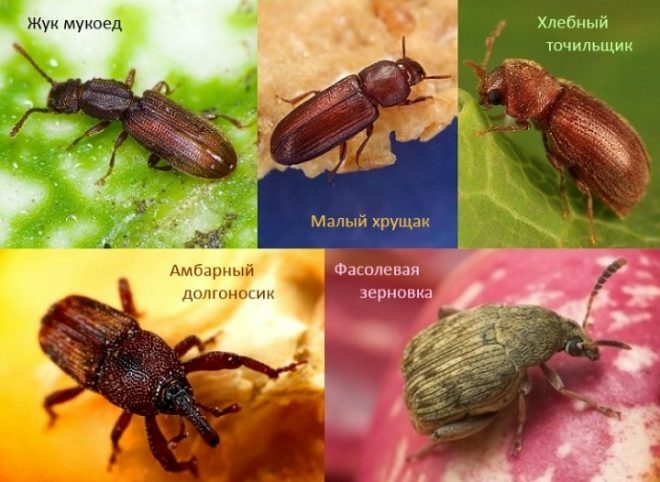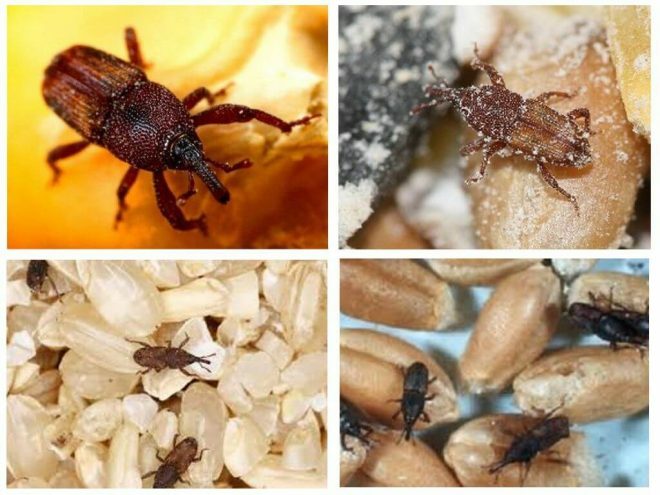Having appeared in the kitchen, bugs begin to destroy all food supplies, this happens very quickly. There are a huge number of food pests, but most of them are small in size, so it is difficult to detect their presence. Small bugs in the kitchen multiply quickly, with an increase in the population, their presence becomes noticeable. This is indicated by spoiled products, blotches or through holes appear in cereals or confectionery products. Next, we will deal with the types of pests and methods of dealing with them.

Varieties of bugs
The following types of bugs are often found in the kitchen:
Attention! Earned on our website kitchen designer. You can familiarize yourself with it and design your dream kitchen for free! May also come in handy wardrobes designer.
- white insects;
- grinder;
- mucoid;
- weevil;
- Khrushchak.
All these pests are small in size, but they multiply quickly and do a lot of harm. Favorable conditions for the development of insects are considered a temperature in the range of 25-30 degrees and high humidity. Parasites feel good even at lower temperatures of about 12-15 degrees.

Small Khrushchak
The body size of this pest is no more than 3 millimeters, the bug has short antennae. The body of the insect is brown, the head is small. The pest lives in bulk products such as starch, semolina or flour. Together with them, he gets into the house and quickly spreads throughout the room. You can determine the appearance of a small beetle by the appearance of small mounds in flour or starch.

Ginger flour eater
Such insects in the kitchen have a reddish color of the body, its size does not exceed 2 millimeters. Unlike the previous pest, the antennae in the mucoeda are quite large. Parasites appear in improperly stored food when the moisture level exceeds 15%.

Bread grinder
It is a small brown beetle, body length up to 4 millimeters. Small hairs cover its body. The insect is distinguished by its extraordinary gluttony, eats not only bread, but also cereals, flour products, beans, peas. If stored improperly, parasites can end up in a can of coffee or in a pack of tea.
Several insects are very difficult to spot, but they multiply very quickly. After a while, they will appear on the countertop or windowsill.

Weevil
The weevil is considered one of the most common pests. He makes holes in pasta or cereals, eats flour. Often a barn weevil enters the kitchen in an apartment or a private house. It differs from its indoor relative by its elongated head. The pest has a dark brown body color, its size does not exceed 4 millimeters. The insect cannot fly through underdeveloped wings.

How beetles enter the house
The main way to enter the house is considered to be the transfer of beetles along with food. Most often, pests settle in cereals or flour. This can occur even at the production stages, especially when the manufacturer does not comply with the technical conditions or rules for the storage of food products.
Insects often appear in the kitchen after purchasing bulk cereals or other products. Pests can also infect new food if they were previously in an unopened jar with loose buckwheat, rice, peas or other types of cereals.
If a dead bug is found on the surface of millet or flour, it means that there were already bugs here, they multiplied and crawled away to look for new food. It is not recommended to consume affected foods.
Reasons for the appearance and principles of storage
In most cases, parasites gnaw expired food. So buckwheat, pasta and rice are stored for 5-6 months, the shelf life of flour is about a year. A product such as oatmeal can be stored for 7-8 months, and polished rice - 1.5 years. Dried fruits, including nuts, are not recommended to be stored in boxes along with flour and cereals.
The appearance and reproduction of pests is facilitated by the increased air humidity in the room. Under favorable conditions, bugs reproduce with high intensity, after a few days their presence will become noticeable. Parasites can find themselves in the most unexpected places. They can be seen in food bags for cats and dogs. To prevent this from happening, food for animals is stored in a dry place in sealed bags with fasteners.
How to fight
Many housewives are wondering how to get rid of bugs in the kitchen after they enter the home. First, you need to check all cereals, bakery and flour products for the presence of parasites. In case of severe damage, food supplies need to be thrown away, but if there are few insects, then you can try to save the cereals. For this, such actions are taken.
Exposure to high temperatures
Heat treatment allows to destroy beetles, many insects die at negative temperatures within the range of -5... -11 degrees. The best effect can be achieved at the lowest possible temperature parameters. In the summer, it is recommended to place spoiled food in the freezer. In winter, flour, cereals, nuts and dried fruits are left for several days on the balcony or outside, then taken into the house. High temperatures can also kill parasites; with such processing, the products are placed in the oven, where the temperature is set at + 50... + 60 degrees.
Furniture and other surface treatment
At the preparatory stage, the kitchen set is cleaned of dust. Then all surfaces are wiped with soapy water. Next, a vinegar solution is applied to the furniture with a damp sponge.
Correct storage
You can save yourself from bugs if you take into account their behavioral and reproductive characteristics. The parasites have well-developed jaws, which allow them to gnaw even the hardest foods, but they will not be able to get into a lidded glass jar or other sealed container. Pests appear most often in plastic bags or damaged packaging, so pour cereals and flour into ceramic, glass or tin containers. They must be kept tightly closed.

Preventive actions
Do not wait for insects to appear in the kitchen, it is better to prevent them from entering, which will keep all foods safe and sound. All preventive actions are reduced to the following:
- After purchasing cereals, flour and other bulk products, spread them on a baking sheet and heat in the oven for 30-40 minutes at a temperature of 50-60 degrees. Another way out of the situation would be to place food supplies in the freezer. Such measures will destroy insects and their offspring, will prevent their further reproduction.
- Each housewife should periodically inspect the stocks for the presence of pests, and if they are detected, take appropriate measures.
- Deterrent agents are placed inside kitchen cabinets, as well as on drawers. This can be garlic, lavender, wormwood, and bay leaves. Such funds can also be put in sealed containers that are used to store bulk products.
- Nuts and dried fruits can be the first on the path of pests, so they are placed on a separate shelf in the refrigerator. With a sufficient amount of space, the same operations are carried out with cereals.
- The hostess should periodically wipe the dust from the cabinets, treat their surface with vinegar solution.
- Carefully seal the gaps between the skirting boards or the gaps in the furniture (you can use putty for this purpose). Pests often accumulate here. To destroy bugs, it is enough to treat the cracks with steam or spill boiling water.
These preventive measures do not allow you to completely get rid of the bugs. To avoid the appearance of insects, do not stock up on food in large quantities. Buy drying, nuts and cereals for a week in advance - no more.
If parasites have been living in the kitchen for a long time, they can cause significant harm to food. Bugs often settle in nuts and cereals, make holes in the grain, eat away flour, tea, coffee, some insects even grind tobacco. The need for a certain type of food is determined by the type of pest. The most common in the kitchen are the flour eater, moth, beetle, weevil and grinder beetle. Slightly damaged products can be saved by influencing the pests of high or negative temperatures, the rest are thrown away.
average rating 0 / 5. Number of ratings: 0
No ratings yet. Be the first to rate.


